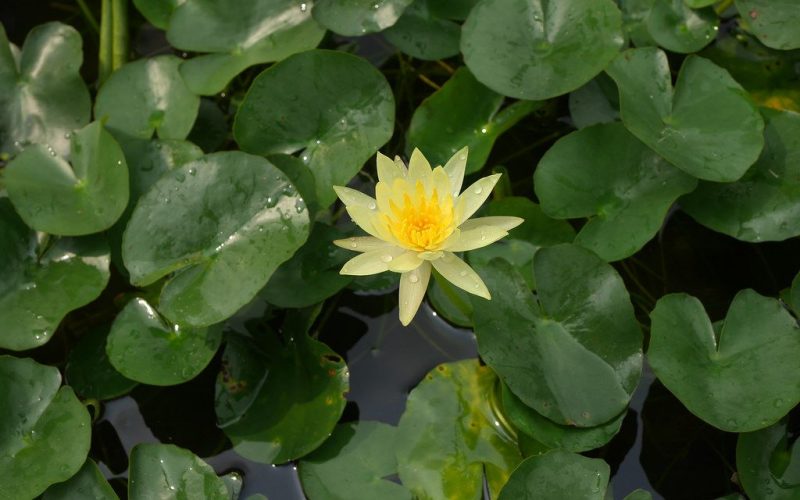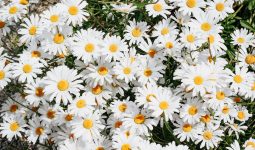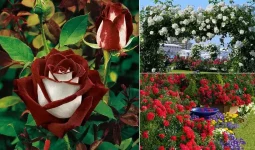Nymphaea Mexicana, also known as yellow waterlily, banana waterlily, or Mexican waterlily is a species of aquatic plant that grows naturally in Mexico as far south as the Michoacan and the Southern United States.
- Scientific name: Nymphaea Mexicana
- Rank: Species
- Higher classification: Water lily
Leaves:
- Oval-shaped
- Up to 9 inches wide
- Fleshy
- Bright-green on top
- Purple or deep-red on bottom
Roots:
- It looks like they’re covered in warts
Flowers:
- 2.36-3.94 inches wide
- Sepals are sword-shaped
- Usually has about 25 petals
- Bright yellow in color
- Elliptical or sword-shaped
Fruit:
- Berry
- Egg-shaped
- 0.78-1 inches long
Seeds:
- 0.16-0.2 inches in diameter
About Nymphaea Mexicana
This perennial plant is part of a family of floating aquatic plants that can grow in ponds and other waters up to 8′ deep. The plant is also called yellow waterlily, banana waterlily, or Mexican waterlily, and its leaves develop straight from the rootstock on long fleshy petioles.
The leaves are 4-12″ across and come in orbicular shape, cleft toward the center on one corner, and smooth on the outer margins.
You will find the upper surface of the plant’s leaf appearing medium green, while the lower surface is usually purplish; it comes in a thick and rather leathery texture. Fine veins are easily spotted radiating outward from the middle of the leaf.
The leaf breathes through the air pores that are located on its upper surface, rather than on the lower surface as is obtainable in other plants.
The long petiole of individual leaves is stout, terete, and purplish; it is mostly covered with algae.
Flower & Leaves of the Nymphaea Mexicana
Long flowering stalks of this plant also develop straight from the rootstock. Each of the plant’s stalk is unbranched and features a single floating flower at its top. The appearance of these stalks looks a lot like the petioles of the leaves.
Each of the plant’s flower is around 3-6″ across; it features four greenish-white sepals beneath that rests nicely on the water surface, and around 20-30 white oval petals above.
In the center of the flower’s petals, you will find several golden-yellow stamens surrounding an individual pistil. The petals of this flower are elliptic-lanceolate and are slightly curved upward.
The outer stamens possess winged filaments that are much wider than the anthers, while you will find narrow filaments on the inner stamens.
The blooming period of this water plant occurs during the summertime and early fall, which makes it a widely love summer aquatic plant. Each flower that buds last only 3-4 days; it is noticed to open up during the morning and close during the noon.
The flowers of this aquatic plant are quite fragrant. After the petals of this plant wither away, a new cycle begins with a globoid multicelled fruit developing; the stalk of this fruit will bend downward, and the fruit matures underwater.
Eventually, this fruit will release its seeds, which will remain afloat upward on the surface of the water. The seeds will be carried about by the wind and water currents; they then sink down to the bottom of the water, where they can germinate.
The plant’s root system consists of long forking rhizomes, as well as coarse fibrous Close-up of the Flower roots. Vegetative colonies of this plant are often formed.
Cultivation
The plant prefers to grow in clear water up to 8′ deep, with sunny conditions on the surface of the water, and mucky soil to hold and nourish the plant’s root system.
The water where it grows should be slow-moving or still with little exposure to waves or high wind. Fragrant Water Lily seems to favor waters that are somewhat acidic rather than alkaline and calcareous.
The plant is able to survive during cold weather, which is not so common for most summer plants.
Range & Habitat
While the whole state is within the range of Fragrant Water Lily in the USA, this one is a rare native plant that can only be found in a few counties in southern Illinois and NE (see Distribution.
Even though the plant is local to the region stated above, it can be domesticated as some people sometimes cultivated in wetland gardens and ponds.
Natural habitats for this water lily include ponds, clear slow-moving rivers, and protected areas of lakes. You can also find this plant in places where dams have been constructed, whether by beavers or humans.
Faunal Associations
The flower has an abundance of pollen, and it attracts tiny bees (mainly Halictid), beetles, and various flies. In particular, the bees Lasioglossum nymphaeum, Lasioglossum nelumbonis, and Hylaeus nelumbonis are oligoleges (specialist visitors) of most flowers of water lilies and other plants that are closely related.
There are also a number of oligolectic insects that eat the leaves and petioles of the water lilies. These insects include the larvae of a wide range of moths, and Sericothrips langei (Waterlily Thrips), including Monroessa gyralis (Pyralid Moth sp.), Synclita obliteralis (Water Lily Leafcutter), Bellura gortynoides (White-Tailed Diver).
The larvae of Galerucella nymphaeae (Water Lily Beetle) and some Donacia spp (Water Lily Leaf Beetles) are known to feed on water lilies; theClose-up of the leaf. Adults are known to feed on either the leaves or the pollen.
In the Midwest, the water lilies do not have so much food that is of value to ducks, as they can only feed on the fruits/seeds and rootstocks, mainly in the Gulf states.
Also interesting is how a range of turtles also feed on the petioles, leaves, and fruits/seeds of this plant, including Chrysemys picta marginata (Midwestern Painted Turtle), Chelydra serpentina (Snapping Turtle), and the Sternotherus odoratus (Musk Turtle).
For beavers and muskrats are great fans of the foliage and rootstocks, as these are one of their favorite sources of food. The White-Tailed Deer can occasionally be seen entering the water to munch on the foliage of water lilies.
For home gardens, this plant survives quite well. However, it is important to provide enough water space and the right temperature to support its survival.
These are the facts you must know about the Nymphaea Mexicana. Kindly leave a comment below.








